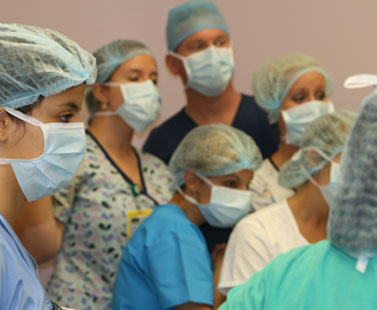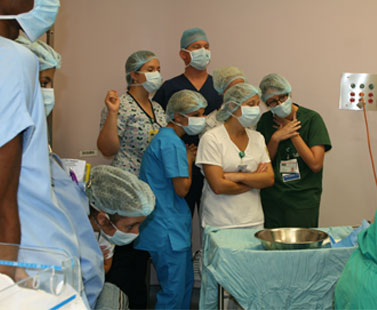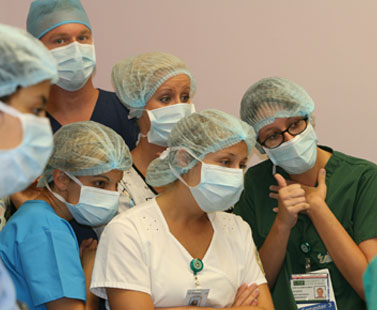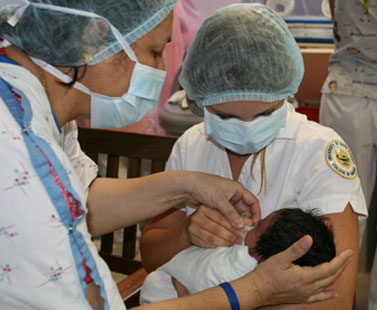'Hola' to Babies in Panama!

USF Nursing Students Visit Panama’s Busiest Labor & Delivery Room
Balboa, Panama June 4, 2008 – It never takes long for mornings to become incredibly busy at the Hostal Amador Familiar. Almost with the first light of day, come the sounds of showers running, hairdryers blowing, coffee brewing and the microwave dinging with breakfast. First ones up always get the hot showers. No one wants to be late. No one wants to be last.
It’s been the same morning routine at the hostal since the arrival of 15 USF nursing students and 2 faculty members in mid May, but on this particular morning something feels different. Their quick steps and increased back & forth to rooms are a dead give away that something new, something extraspecial will be happening on this day. The anticipation in the air is palpable.
“I hope we see a baby today,” says one student. “I hope we see a couple of babies!” says another. Then, a rapid exchange on the topic of scrubs: “Do you have your scrubs? I have mine…don’t forget to bring yours…mine are dirty?!… I may have extra…” The conversation is critically important because having scrubs will be the key to the something special happening today. No scrubs, no delivery room. No delivery room, no babies.
“Profesora” Lucero de Estrada, RN, of the University of Panama’s Nursing School has arranged for a three-hour-tour of the Santo Tomas Maternity Hospital in the capitol, and these Bulls are hoping to witness at least one delivery during the visit. With interests as varied as their personalities and backgrounds, this year’s group is pursuing nursing specialties in cardiac care, geriatrics, neurology, oncology, anesthesiology, labor & delivery – just to name a few. But on this hot, humid morning, their areas of specialties all take a backseat to “birth”.
Jason Merry, the only male student in the group, explains things this way. “A person once told me, there could be seven people in the (delivery) room and the next thing you know, there are eight! Ever since I heard that, it’s the only way I think about birth. It’s amazing…there’s another life in the room…” he says.

Arrival at Santo Tomas Maternity Hospital…
The arrival at Santo Tomas Hospital is marked by long welcomes and formal introductions. Over three hundred years old, the hospital is rich in history & tradition, and its proud nurses are brimming over with stories to share. Santo Tomas is one of only two large, public maternity hospitals in this nation of just over 3 million people. Its labor & delivery rooms, the busiest on the isthmus. Last year approximately 12,000 babies were delivered here. So far this year, the hospital is averaging 35 – 40 births a day. Women from all over the countryside travel here to delivery their babies at a cost of $25 U.S. dollars for a vaginal delivery, $50 U.S. dollars for a Cesarean- section. In modern Panama, the U.S. dollar has become the nation’s currency. No patient is turned away, regardless of whether they can pay their bill in full, in part, or not at all.
Finally in the Sala de Parto!
USF students have plenty of questions, asking about immunizations, prenatal care, and HIV testing prior to delivery. While their hosts are happy to answer the steady flow of questions, word comes that the head doctor has given permission for USF students to enter the Sala de Parto – Labor & Delivery. They reach for their backpacks with scrubs tucked inside.
“We were all really excited, but we didn’t think that we were going to be able to see a delivery,” says Alexandra “Lexa” Henry. “We were looking up at the clock and thinking ‘Oh, we’re going to have to go soon.’ …then, all of a sudden, two ladies that came in were in labor! It was great!”
Great indeed! With both patients giving the okay for USF nursing students to enter, they split into smaller groups, change into their scrubs and head for the delivery rooms.
Humbled by the inclusion in such a personal moment, our students stand quietly in the corner of the delivery room – eyes wide…at times, almost holding their breath…watching everything and everyone.


Caitlin Brock and Jason Merry are in the back. Caitlin inches forward on the tips of her toes to watch the final push, while Courtney Rice bends her knees and leans in to get a clearer view. Lydia Pendino and Jessica Dorey are wringing their hands, while Erin Smith keeps hers firmly planted over her heart.

Erin suddenly switches over to a ‘thumbs up’ after seeing the baby boy’s head emerge from the birth canal.

In the span of only eight minutes, our students had witnessed the birth of two babies – a girl born at 11:44 AM…a boy born at 11:52 AM.
“I feel that giving birth is such a personal, special experience, and for us to be able to share that with her, it was really cool,” says Caitlin Brock.
Q: I cried a little. Did you?
“I was very teary. I didn’t expect to get so emotional to see the baby born. I didn’t know the lady, but I definitely got emotional.”
“It was breathtaking, the whole experience!” says Christine Doherty.
“Even from the medical perspective, it was a beautiful thing,” says Jessica Meerbott, who witnessed the birth of the baby girl in the next room. “I didn’t start to get emotional until I went over and looked at the baby. She was just so beautiful and peaceful, this little bundle of life and I got to be a part of that. It was just very special,” she says.
The Panamanian mom informs the nurse that her daughter’s name is Kimberly, and with her permission, our students take out their cameras for the first time and take a picture. The Santo Tomas nurses stop to smile and remark, in Spanish, about the tenderness and respect exhibited by these students.

Holding the babies…
Profesora Estrada is pleased. Every single one of her USF estudiantes – students- for the day has witnessed a birth. Still in her scrubs, she leads them into the room where babies are being washed and diapered. Once inside the profesora begins helping our students hold babies and feed them milk out of an espresso-size cup. “un poquito, only a little,” she says. “We don’t use bottles to make it easier for the baby to breastfeed,” she explains.

Q: Profesora Estrada it must give you great satisfaction as you watch students and see when they are really engaged in the learning process, fully experiencing the moment?
“Yes, it’s a great satisfaction,” she responds. “We are professionals and see deliveries all the time, but when you observe the delivery for the first time, it stays with you forever! And also, it will prepare you for the future,” concludes Estrada, who’s been a nursing professor in Panama for almost three decades.
For Tara Casimir, the experience at the Santo Tomas Hospital is only part of a greater story she has to tell of the month long exchange program in Panama – how it’s changed her perspective about life and even herself. “It’s given me so much more confidence… especially with the language barrier and yet I’ve done so many things here…it’s really tested my own abilities,” she says.
Q: Does this make you more certain of your choice to pursue nursing?
“Yes, for sure!” says Tara without hesitation.
Now home in the U.S., students share that day’s anticipation & the babies with friends & loved ones, near and far. Taken in by the miracle of life, they are moments students say they will never forget.

Story by Lissette Campos, USF Health Communications
OTHER LINKS:
PHOTO GALLERY – HOSPITAL SANTO TOMAS
Audio Clips of Birth in Progress

